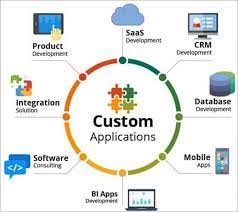Mastering Web App Programming: Building Dynamic and Responsive Applications
The World of Web App Programming
Web application programming is a dynamic and exciting field that continues to evolve rapidly in today’s digital age. Web applications are software programs that run on web servers and are accessed through web browsers, making them accessible across different devices and platforms.
Developing web applications requires a combination of programming languages, frameworks, and tools to create interactive and engaging user experiences. Some popular programming languages used in web app development include HTML, CSS, JavaScript, Python, Ruby, PHP, and more.
The Role of Frontend Development
Frontend development focuses on creating the user interface and user experience of a web application. It involves using HTML for content structure, CSS for styling elements, and JavaScript for interactivity. Frontend developers work closely with designers to bring the visual aspects of a web app to life.
The Importance of Backend Development
Backend development involves building the server-side logic that powers the functionality of a web application. This includes handling data storage, user authentication, server communication, and more. Popular backend technologies include Node.js, Ruby on Rails, Django, and Laravel.
Frameworks and Libraries
Frameworks and libraries play a crucial role in simplifying web app development by providing pre-written code snippets and tools for developers to use. Popular frontend frameworks like React.js, AngularJS, and Vue.js help streamline frontend development tasks.
Responsive Design
In today’s mobile-first world, responsive design is essential for ensuring that web applications look great and function smoothly on various devices such as smartphones, tablets, and desktops. CSS frameworks like Bootstrap make it easier to create responsive layouts.
Continuous Learning
Web app programming is a constantly evolving field with new technologies emerging regularly. Developers need to stay updated with the latest trends, tools, and best practices to build modern and efficient web applications that meet user expectations.
Overall, web app programming offers endless possibilities for creating innovative solutions that cater to diverse user needs. Whether you’re a frontend developer focusing on user interfaces or a backend developer handling server-side logic, mastering web application programming opens up exciting opportunities in the digital realm.
9 Advantages of Web App Programming: From Accessibility to Community Support
- 1. Accessibility
- 2. Cross-Platform Compatibility
- 3. Easy Updates
- 4. Cost-Effective Development
- 5. Scalability
- 6. Search Engine Optimization (SEO)
- 7. Integration Capabilities
- 8. Real-Time Updates
- 9. Community Support
Top 5 Challenges in Web App Development: Navigating Complexity, Compatibility, and More
1. Accessibility
One significant advantage of web app programming is its accessibility. Web applications can be accessed from anywhere as long as there is an internet connection available, providing users with unparalleled convenience and flexibility. This means that users can interact with web apps on various devices, such as smartphones, tablets, and computers, without being limited by location or operating system. The ability to access web apps seamlessly from different environments enhances user experience and ensures that information and services are readily available whenever needed.
2. Cross-Platform Compatibility
One significant advantage of web app programming is its cross-platform compatibility. By running on web browsers, web applications can seamlessly operate on a wide range of devices and operating systems. This versatility eliminates the need for separate versions tailored to specific platforms, making it easier for users to access and use the app regardless of the device they are using. This flexibility not only enhances user experience but also simplifies maintenance and updates for developers, ultimately resulting in a more efficient and accessible solution for all users.
3. Easy Updates
One significant advantage of web app programming is the ease of updates. With updates deployed centrally on the server, all users can access the latest version instantly. This streamlined process ensures that users always have access to the most up-to-date features and improvements without the need for manual installations or individual updates on each device.
4. Cost-Effective Development
One significant advantage of web app programming is its cost-effective development process. Creating web applications typically involves lower investment costs in comparison to developing native mobile apps or desktop applications. This cost efficiency makes web app development an attractive option for businesses looking to establish a strong online presence without breaking the bank. By leveraging web technologies, companies can reach a broader audience while keeping development expenses in check, making it a smart choice for budget-conscious projects.
5. Scalability
One significant advantage of web app programming is scalability. Web applications have the flexibility to expand and adapt to a growing user base without the need for major infrastructure modifications. This means that as the demand for the application increases, developers can easily scale up the resources to ensure optimal performance and user experience without disrupting the existing functionality. This scalability feature allows web apps to handle increased traffic efficiently, making them a practical choice for businesses and organizations looking to grow their online presence seamlessly.
6. Search Engine Optimization (SEO)
One significant advantage of web app programming is the ability to enhance Search Engine Optimization (SEO) capabilities. By optimizing web applications for search engines, businesses can improve their online visibility and attract a higher volume of organic traffic. This proactive approach to SEO not only helps in reaching a broader audience but also contributes to better search engine rankings, ultimately leading to increased brand exposure and potential customer engagement.
7. Integration Capabilities
Integration capabilities are a significant advantage of web app programming. Web applications have the ability to seamlessly integrate with various services and APIs, allowing for enhanced functionality and a more cohesive user experience. By leveraging integration capabilities, web apps can tap into external resources, share data across platforms, and offer users a more comprehensive and interconnected experience. This flexibility in integration empowers developers to create versatile and feature-rich web applications that meet the evolving needs of users in today’s interconnected digital landscape.
8. Real-Time Updates
One significant advantage of web app programming is the ability to provide real-time updates to users effortlessly. Web applications can push notifications and updates instantly to users without the need for manual refreshes, enhancing user engagement and keeping them informed with the latest information in a dynamic and interactive manner. This feature not only improves user experience but also ensures that users stay up-to-date with relevant content or changes without any delay.
9. Community Support
The pro of web app programming lies in the extensive community support available to developers. The web development community is vast and active, providing a wealth of resources, tutorials, and support for individuals working on web applications. This collaborative environment allows developers to learn from each other, share knowledge, and troubleshoot challenges effectively, fostering continuous growth and innovation in the field of web app development.
Complexity
The complexity of web app programming poses a significant challenge for developers, as it demands a deep understanding of various programming languages, frameworks, and tools. Juggling multiple technologies can lead to intricacies in code implementation, debugging, and maintenance. This complexity can also result in longer development times and increased likelihood of errors if not managed effectively. As a result, developers need to invest time and effort in continuous learning to stay abreast of the ever-evolving web development landscape and ensure the successful execution of web applications.
Browser Compatibility
Browser compatibility is a significant challenge in web app programming, as ensuring that web applications work seamlessly across various browsers can be both challenging and time-consuming. Different browsers interpret code differently, leading to inconsistencies in how a web app functions or appears. Developers must thoroughly test their web apps on multiple browsers and versions to identify and address compatibility issues, adding complexity to the development process and potentially delaying project timelines. Failure to prioritize browser compatibility can result in a poor user experience and hinder the overall success of the web application.
Security Vulnerabilities
One significant drawback of web app programming is the prevalence of security vulnerabilities. Web applications are often targeted by malicious actors, leading to potential risks such as data breaches, cross-site scripting (XSS) attacks, and SQL injection vulnerabilities. These security threats can compromise sensitive user information, undermine the integrity of the application, and pose a significant risk to both users and the organization hosting the web app. Mitigating these security vulnerabilities requires diligent coding practices, regular security audits, and staying informed about the latest cybersecurity trends to protect against potential exploits.
Performance Issues
Performance issues are a significant drawback of web app programming, as optimizing web app performance for speed and responsiveness on various devices can be a constant struggle. Ensuring that a web application loads quickly and functions smoothly across different platforms and network conditions requires careful attention to detail and continuous monitoring. Performance tuning, minimizing resource-intensive processes, and optimizing code are essential steps to address these challenges and provide users with a seamless experience. Failure to prioritize performance optimization can lead to frustrated users, high bounce rates, and ultimately impact the success of the web application.
Maintenance Overhead
One significant con of web app programming is the maintenance overhead involved in keeping web applications up-to-date with evolving technologies and addressing bugs. This process can be time-consuming and demanding, requiring continuous effort to ensure that the web app remains functional and secure. Developers need to stay vigilant in monitoring for updates, implementing necessary changes, and troubleshooting issues to maintain the overall performance and user experience of the web application.




